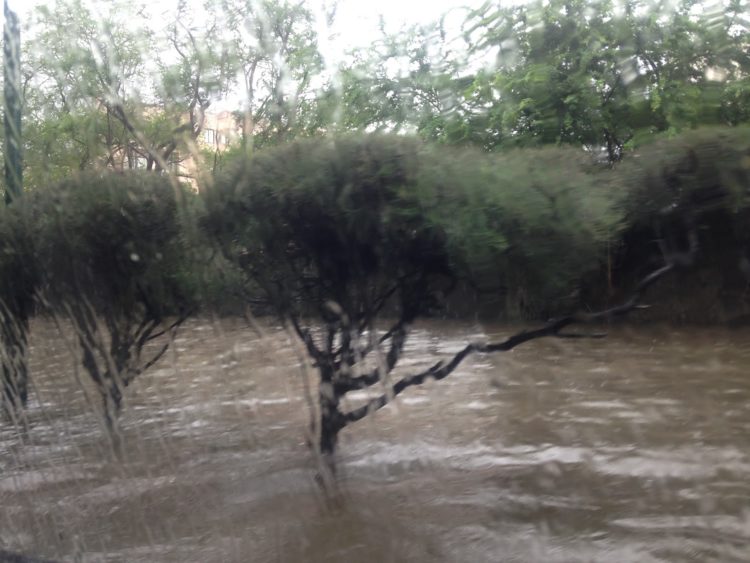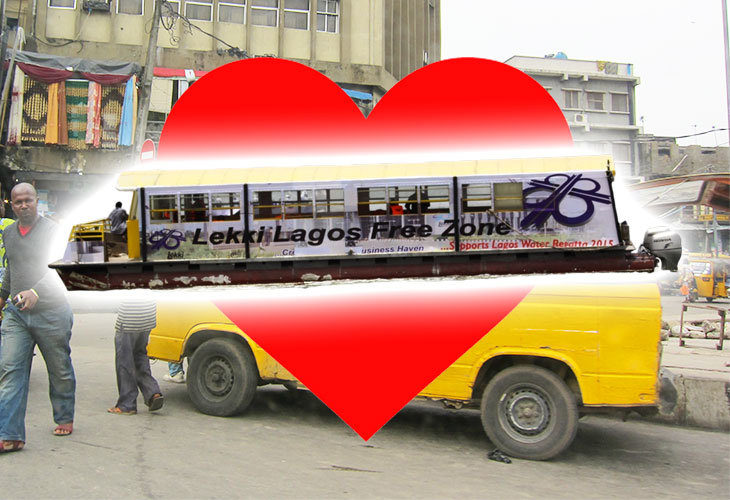For 30 days, I will live on the Nigerian national minimum wage. I want to raise awareness of the falling standards of living in the country. N18,000, which is roughly USD$49.7, GBP £35, and EUR €44 equates to N600 a day. That is approximately US$1.8.
This is my account of my journey. You can read about how it all began here.
I once had a conversation with my Uber driver where he said that the biggest infrastructural problem faced by Nigerians is the power supply. I agreed with him on that day and we talked about how many more people could engage in entrepreneurship and become more independent if there was steady power supply. However, after a few trips without my car or Uber, I feel strongly that the issue of transport is just as important as the lack of power supply.
Living on the minimum wage sucks but having to survive on next to nothing in a city with a costly and ineffective transport system makes it worse.
Living on the minimum wage sucks but having to survive on next to nothing in a city with a costly and ineffective transport system makes it worse. My anxiety levels have risen and my quality of life has dropped. There seems to be so much to do and to think about. In addition to carefully planning and preparing what I eat, I need to plan where I can afford to pay to get to. I am constantly worrying about how to get a free ride because I know that spending freely on transport will destroy my budget in a matter of days.
It would be a great big lie to tell you that I wasn’t feeling exhausted or shattered. My sleep monitor tells me I sleep for seven hours on average since I started the challenge but I find it hard to be productive at work feeling this exhausted. I’ve decided to blame the fatigue and a lack of productivity on the mess of the public transport system in Lagos.
I downloaded an app to monitor my steps. It's telling me it's time for bed. Clearly doesn't know about lagos hustle. pic.twitter.com/mqAesL7oz2
— Ifeatu (@ifeatunnaobi) June 28, 2016
To survive on the minimum wage means I am constantly looking for free transportation where I can get it. This inadvertently means that I cannot live on my own schedule but need to work with the schedule of the gracious person giving me a ride. On Monday morning, I refused to believe my eyes when I walked through the office gates and noticed that Tolu’s car was missing. It was nearly 10am and I was planning on riding home with him. I had already spent half of my daily allowance on getting to the office and I had walked long intervals to make sure I was spending the lowest possible amount.
On the day it rained last week, I did not bother leaving the house because I wasn’t ready to swim.
To save further on transport, I spent Sunday night with a friend who works close to my office. She makes the typical Mainland-Island commute which I think is inhumane. It begins at 4am everyday when her alarm goes off. She takes a quick shower and drives like a speed-demon so that she can get a decent parking spot in front of her office. She then hops over to the backseat and tries to sleep until 7:30 am when she wakes up, does her make-up, puts her heels on and heads into the office. I have secretly wanted to do this journey with my friend for a while. I imagined it would be like a cool sleepover. We would both manage to fit into the back somehow, have our blankets, and maybe tell scary stories until we fall asleep.
When I did this on Monday morning, there was nothing cute about it. As someone who can saunter into work at whatever time I like, waking up at 4am was difficult. I tried to move less like a zombie and do things faster because my friend was already complaining that we were running late. When we got to her office, I reclined the seat and put on some sunglasses. I couldn’t fall asleep because people kept walking up and down the street, talking really loudly and asking each other, ‘How was your night?’, as if the night was over. Needless to say, I was shattered when I got to my office and spent my day browsing the internet. I spent a good part of my morning researching some caterpillars I over the weekend. They are called Brithys crini and will eventually turn into black and white moths. Very useful information!
The difficulty of the transport system in Lagos is further compounded by the weather. Whenever it rains, the city of 21 million people gets tossed into chaos. The irony is that it rains for a season, yet the streets get flooded in the amount of time it takes to cook a pack of noodles. On the day it rained last week, I did not bother leaving the house because I wasn’t ready to swim.
Since the fuel price went up, transport prices have skyrocketed but this doesn’t mean that people go out less in Lagos.
I’m lucky that I can work from home because my job is flexible and I have decent power supply. I know that everyone else who relies on public transport and had urgent business made that swim. I feel sad that many who are affected by flooding in Lagos don’t put pressure on the Lagos State Planning and Environmental Monitoring Authority to create proper drainage systems and to make sure that people don’t build or take adequate precautions in areas with a high propensity to flooding. Instead they just make sure to buy a 4×4 vehicle like a Prado jeep or a Range Rover, that can maneuver through floods.
Since the fuel price went up, transport prices have skyrocketed but this doesn’t mean that people go out less in Lagos. They are still forced to because the city has developed in a manner where there is little enforcement on house rents, so very few people can afford to live near to where they work. The bus system works OK (minus heavy traffic congestions) when you have to make a trip along the major road but once you have to go further in, you could end up paying exorbitant prices for a short distance ride. For example, I pay N200 from VGC to Law School (that’s about 45 minutes on a good day on the bus) but pay N100 Keke from Adeola Odeku to Idejo (that’s a five-minute ride).
https://www.instagram.com/p/BHO_r7rBCx_/?taken-by=ifeatunnaobi
My time spent traveling to work and back has doubled because I have to dedicate an additional hour to just walking. That is time I could spend working or doing something else. I normally do some kind of creative work in the evenings, catch up with friends, watch a TV show, write or read but I haven’t done any of those things since I started using public transport because it leaves me so exhausted. Lagos Metropolitan Area Transport Authority (LAMATA), admits that the road network density of Lagos is low, even by standards of African cities. There is a limited number of primary roads carrying the bulk of the traffic. In addition to that, inadequately designed interchanges and a poor drainage system makes many of the roads impassable or highly congested.
Because Lagos is a sprawling city, it has become a society reliant on cars. Megacities around the world understand that you don’t solve the problem of congested roads by widening the roads.
Over the last decade, Lagos state has tried to improve the public transport system. The BRT buses were introduced along eight corridors in Lagos. They have special lanes on the Mainland but still haven’t implemented these on the Island. On the Island, we primarily still rely on the smaller motor vans for public transport. Last Wednesday night, as I went home from work, Tolu and I noticed the overwhelming majority of cars on the road that had just one driver. This means that there were so many cars that did not need to be on the roads if there was a better public transport system. In a Bloomberg documentary I watched over the weekend, it was acknowledged by Gridlock Sam (former NYC traffic commissioner) that the math of cars does not work. ‘If you were to take out the passengers in a typical New York City subway train and put them in cars, they would take up 300 times as much space.’
I've started keeping a #MinWageChallenge Diary- Read about Day 4; The Bus Can Be a Dangerous Place. https://t.co/m353kOA0m8
— Ifeatu (@ifeatunnaobi) June 23, 2016
Because Lagos is a sprawling city, it has become a society reliant on cars. Megacities around the world understand that you don’t solve the problem of congested roads by widening the roads. Adding lanes makes driving more attractive and increases the traffic. Creating and improving a system of mass transit is the key. London, for example is expanding its metro system, the largest in Europe, through Crossrail, a high-speed, high-frequency network that will add more than 60 miles of track and 10 new stations to London’s underground network.
In China, a Beijing company has plans to introduce an elevated bus that rides over cars. It will be powered by a combination of solar and electricity, costs less than the subway, carries 1,400 people at a go, and can be built within a year. Other scientists are working on smarter cars that use vehicle-to-vehicle systems that communicate with each other. They can better manage the innately selfish behaviours of drivers that cause traffic jams and they re-route cars to avoid congested areas.
Someone needs to be doing more to let people understand that traveling my water is a viable option.
We might not be able to achieve all these high-tech solutions in Lagos but we have some resources to start with. Lagos state is blessed with waterways that reportedly transports as many as two million people each month. The Lagos State Waterways Authority (LASWA) has its mission as ‘To regulate and promote the use of Lagos inland waterways, encourage sustainable investments and develop lasting water transport solutions for the people of Lagos state.’
The agency recently announced plans to increase safety measures, and build new jetties, so as to increase the number of people who rely on the waterways for their transport. Although, this is questionable in light of recent allegations by private ferry operators Tarzan Marine Nigeria Ltd. and Metro Ferry of eviction from jetties, by the agency. Tarzan contends that LASWA unfairly evicted it from its Badore, Ijede, Oke-Nla and Ibeshe jetties. A second operator Metro Ferry has been evicted from their jetty in Oworonshoki because they breached the terms of approval for operations. Boat Operators claim that what ‘LASWA should be doing is to provide facilities like filling station on the waterways, clearing of debris, wrecks, water Hyacinth, and illegal dredging of sand on the waterways instead of blaming boat operators anytime there is accident.’
It seems that the rules of water transport in Lagos are not fully agreed upon by all stakeholders. When I went on the LAWSA website to learn more about ferries in Lagos, there was no information available. I called a few of the operators to learn more but the fellow who agreed to share his records with me said he would rather do it in person, in a week’s time. Nevertheless, someone needs to be doing more to let people understand that traveling by water is a viable option.
BRT buses carry approximately 200,000 people a day. Based on that metric alone, you can start to imagine the huge scale of the transportation problems and opportunities in Lagos.
BRT buses carry approximately 200,000 people a day. Based on that metric alone, you can start to imagine the huge scale of the transportation problems and opportunities in Lagos. There is room to build a system that is reliable, predictable and convenient. If we were to start by just creating a special lane for the BRT buses along the Lekki-Epe Expressway and get the small vans off that road by transitioning some of them to the inner roads, and enforce stopping at bus stops only and replace those bloody roundabouts with traffic lights, we definitely would be giving people back some control and quality of life.
As it is now in Lagos, the answers to ‘How does one go to where the opportunities are?’, ‘How does one meet an appointment?’ and ‘How does one make the most efficient and best use of their time?’ are either ‘You don’t’ or ‘By the grace of God’.




